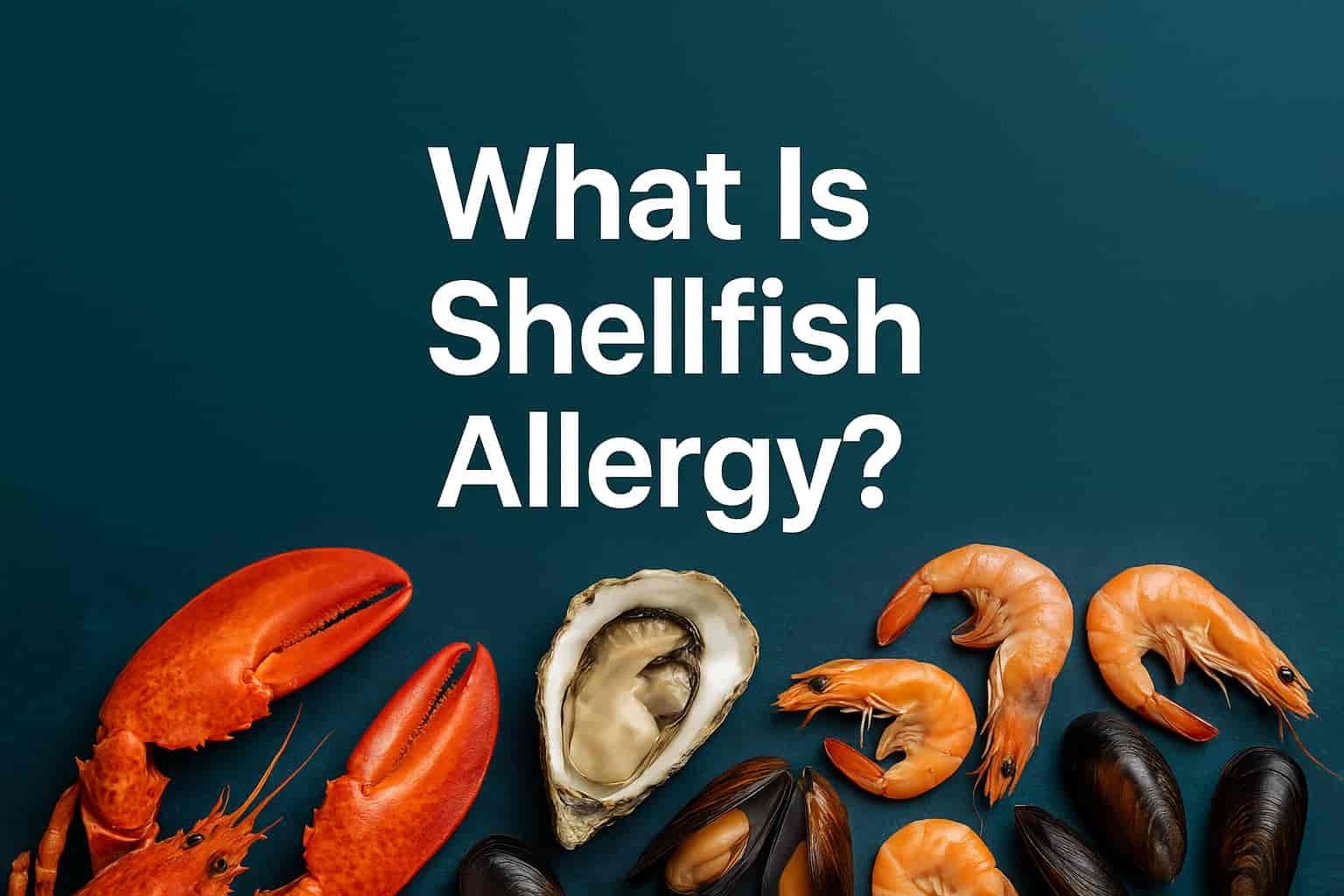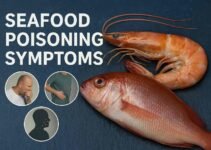Shellfish allergy is a medically recognized food allergy that affects approximately 2% of adults and 1% of children worldwide. It occurs when the immune system mistakenly identifies certain proteins in shellfish as harmful, triggering a defensive response. Unlike other food allergies that children can outgrow, shellfish allergy typically develops in adulthood and persists for life. This makes understanding the triggers, symptoms, and management strategies crucial for maintaining safety.
There are two primary categories of shellfish that cause allergic reactions: crustaceans (such as shrimp, crab, and lobster) and mollusks (including clams, oysters, and squid). Among these, crustaceans are responsible for the majority of severe allergic responses.
In this guide, you will learn exactly what causes shellfish allergy at the biological level, which types of shellfish are most dangerous, and how to recognize the earliest signs of an allergic reaction. Each section provides clear, actionable information backed by scientific data, ensuring that you can make informed decisions to protect your health or support someone who is living with this condition.
Contents
- 1 What Causes Shellfish Allergy at the Biological Level?
- 2 What Types of Shellfish Commonly Cause Allergies?
- 3 What Are the Early Signs of a Shellfish Allergy Reaction?
- 4 How Severe Can Shellfish Allergy Symptoms Become?
- 5 How Can You Diagnose Shellfish Allergy Accurately?
- 6 What Are the Best Practices for Managing Shellfish Allergy Daily?
- 7 Can Shellfish Allergy Develop Later in Life?
- 8 What Are Safe Alternatives for Shellfish in Recipes?
- 9 How Do Restaurants Handle Shellfish Allergy Requests?
- 10 Is There Any Ongoing Research or Cure for Shellfish Allergy?
What Causes Shellfish Allergy at the Biological Level?
Shellfish allergy is caused by an overreaction of the immune system to specific proteins found in shellfish, primarily tropomyosin. Tropomyosin is a muscle protein present in both crustaceans and mollusks and is highly resistant to heat and digestion, making it a stable allergen even after cooking.
Which Proteins in Shellfish Trigger Allergic Reactions?
The two primary allergens in shellfish are tropomyosin and arginine kinase. Tropomyosin is responsible for over 75% of allergic responses in shellfish-sensitive individuals. Arginine kinase, while less common, also plays a significant role, particularly in cross-reactivity between different shellfish species.
How Does the Immune System Misinterpret Shellfish Proteins?
The immune system misidentifies tropomyosin as a harmful pathogen, leading to the production of Immunoglobulin E (IgE) antibodies. Upon subsequent exposure, these antibodies trigger the release of histamine and other chemicals, causing symptoms such as hives, swelling, breathing difficulties, and in severe cases, anaphylaxis.
What Types of Shellfish Commonly Cause Allergies?
Crustaceans are responsible for the majority of severe shellfish allergies, accounting for nearly 90% of reported cases. Mollusks also pose a risk but are generally associated with milder reactions.
Are Crustaceans More Allergenic Than Mollusks?
Yes. Crustaceans such as shrimp, crab, and lobster are the top three culprits behind severe allergic reactions. Their high concentration of stable tropomyosin makes them particularly dangerous for allergic individuals. Mollusks, including clams, oysters, mussels, and squid, contain tropomyosin but in lower quantities, resulting in less frequent and milder reactions.
Is Cross-Contamination Between Shellfish Types a Serious Risk?
Cross-contamination is a significant risk factor and can trigger allergic reactions even without direct shellfish consumption. Studies show that shared cooking surfaces and utensils can transfer enough allergenic protein to cause a reaction. Individuals with severe allergies must exercise extreme caution when dining out or consuming processed foods.
What Are the Early Signs of a Shellfish Allergy Reaction?
The early signs of a shellfish allergy typically appear within 30 minutes after consumption and involve the skin, respiratory system, and digestive tract. Recognizing these signs promptly can prevent escalation to severe reactions.
How Quickly Do Symptoms Appear After Eating Shellfish?
Symptoms generally begin within 5 to 30 minutes after exposure to shellfish proteins. In some rare cases, delayed reactions may occur after several hours, especially when the allergen load is low or combined with physical activity (known as food-dependent exercise-induced anaphylaxis).
Which Body Systems Are Typically Affected First?
The first body systems affected are:
- Skin: Itching, redness, hives (urticaria), and swelling, especially around the lips and eyes.
- Respiratory System: Nasal congestion, sneezing, wheezing, and shortness of breath.
- Digestive System: Nausea, abdominal cramps, vomiting, and diarrhea.
Immediate medical attention is required if symptoms escalate to involve the cardiovascular system, such as a rapid heartbeat or a drop in blood pressure.
How Severe Can Shellfish Allergy Symptoms Become?
Shellfish allergy can lead to life-threatening reactions, including anaphylaxis, in approximately 15% of cases. Severity depends on the individual’s sensitivity, amount of allergen ingested, and how quickly treatment is administered.
What Is Anaphylaxis and How Is It Related to Shellfish Allergy?
Anaphylaxis is a rapid-onset, life-threatening allergic reaction that can affect multiple body systems simultaneously. It is characterized by symptoms such as difficulty breathing, severe swelling of the throat, a sudden drop in blood pressure, dizziness, and unconsciousness. Shellfish ranks as one of the top three food allergens responsible for anaphylactic reactions worldwide. Immediate administration of epinephrine (adrenaline) is required to prevent fatal outcomes.
How Often Do Shellfish Allergies Lead to Emergency Situations?
According to clinical data, emergency room visits due to shellfish allergy account for approximately 20% of all food allergy emergencies. Individuals with a history of severe reactions have a higher likelihood of recurrence, which underscores the importance of carrying an epinephrine auto-injector at all times.
How Can You Diagnose Shellfish Allergy Accurately?
Shellfish allergy is diagnosed through a combination of patient history, skin prick tests, blood tests, and, in some cases, controlled oral food challenges conducted under medical supervision. If you’re also concerned about general seafood reactions, refer to our detailed guide on Seafood Allergy Symptoms Explained for a broader perspective.
What Are the Most Reliable Medical Tests for Shellfish Allergy?
- Skin Prick Test (SPT): Provides results within 15–20 minutes and is considered highly reliable for detecting IgE-mediated allergies.
- Specific IgE Blood Test (ImmunoCAP): Measures the level of IgE antibodies specific to shellfish proteins. A value above 0.35 kU/L indicates sensitization.
- Oral Food Challenge (OFC): Considered the gold standard, this test involves consuming small, controlled amounts of shellfish under strict medical supervision to confirm a diagnosis.
Can an Elimination Diet Confirm a Shellfish Allergy?
An elimination diet helps identify triggers by systematically removing shellfish from the diet and observing whether symptoms resolve. However, this method should only be used as a preliminary assessment and not as a definitive diagnostic tool. Medical tests are required to confirm the diagnosis and determine the severity of the allergy.
What Are the Best Practices for Managing Shellfish Allergy Daily?
Effective management of shellfish allergy involves strict avoidance of allergenic foods, careful label reading, and preparedness for emergency situations. Adhering to these practices reduces the risk of accidental exposure and severe allergic reactions.
How Can You Read Food Labels to Avoid Hidden Shellfish Ingredients?
To avoid hidden allergens, carefully examine ingredient lists for common shellfish terms such as shrimp, crab, lobster, clam, oyster, scallop, squid, and mussels. Additionally, watch for less obvious terms like “seafood flavoring,” “surimi,” and “glucosamine,” which may be derived from shellfish.
In the United States, the Food Allergen Labeling and Consumer Protection Act (FALCPA) requires shellfish allergens to be clearly declared on packaged foods. However, cross-contamination warnings like “may contain traces of shellfish” are voluntary, so additional caution is necessary.
What Should You Carry for Emergency Situations?
Individuals with a confirmed shellfish allergy must always carry:
- An epinephrine auto-injector (e.g., EpiPen) – the first line of defense in severe reactions.
- Antihistamines – useful for mild to moderate allergic symptoms.
- A medical alert bracelet or card – to inform first responders of the condition during emergencies.
Regularly check medication expiration dates and ensure that friends, family, and coworkers know how to administer epinephrine if needed.
Can Shellfish Allergy Develop Later in Life?
Yes, shellfish allergy frequently develops in adulthood, and once it appears, it is typically lifelong. This late-onset pattern distinguishes it from other food allergies, which often develop during childhood.
What Are the Common Triggers for Adult-Onset Shellfish Allergy?
- Increased seafood consumption, particularly in regions where seafood is a dietary staple.
- Immune system changes due to aging or underlying health conditions.
- Cross-reactivity with environmental allergens, such as dust mites and cockroaches, which share similar protein structures with shellfish allergens like tropomyosin.
Are Genetic Factors Involved in Late-Onset Food Allergies?
While genetic predisposition plays a role in food allergies generally, adult-onset shellfish allergy is more influenced by environmental exposures and immune system changes rather than direct hereditary factors. Individuals with a family history of allergies do have a higher baseline risk, but lifestyle and exposure are the primary triggers for adult onset.
What Are Safe Alternatives for Shellfish in Recipes?
There are multiple plant-based and non-allergenic alternatives that effectively replace the texture and flavor of shellfish in recipes. These options allow individuals to enjoy seafood-inspired dishes without health risks.
Which Plant-Based Ingredients Mimic Shellfish Texture and Flavor?
- King oyster mushrooms – provide a chewy, meaty texture similar to scallops when sliced and sautéed.
- Jackfruit – often used as a substitute for crab or shredded lobster due to its fibrous consistency.
- Hearts of palm and artichoke hearts – mimic the delicate texture of shellfish in salads and pasta dishes.
Are There Allergen-Free Seafood Substitutes on the Market?
Yes, several food brands offer plant-based seafood alternatives made from ingredients such as konjac root, seaweed, and legumes. These products are specifically formulated to replicate the taste and texture of shrimp, crab, and scallops without containing shellfish allergens. When purchasing, always verify that the products are certified allergen-free to ensure safety.
How Do Restaurants Handle Shellfish Allergy Requests?
Restaurants are required to follow strict food safety guidelines, but practices vary significantly, making clear communication essential for individuals with shellfish allergy. Even with precautions, cross-contact remains a leading cause of accidental allergic reactions when dining out.
What Questions Should You Ask Before Ordering?
To reduce risks, always ask the following:
- “Do you prepare shellfish in the same cooking oil or on shared surfaces?”
- “Can the kitchen guarantee that my meal is free from shellfish contact?”
- “Is there a dedicated allergen-free preparation area?”
Always inform restaurant staff about the severity of the allergy. Request to speak directly with the chef if possible to ensure your dietary restrictions are fully understood.
How Can You Reduce the Risk of Cross-Contact in Restaurant Kitchens?
- Dine at allergy-aware restaurants that advertise specific protocols for food allergies.
- Avoid buffet-style dining and seafood-specialty restaurants, where cross-contact is difficult to control.
- Order simple dishes with minimal ingredients to lower the chance of contamination.
Carry an epinephrine auto-injector even if you trust the restaurant’s procedures, as no environment is completely risk-free.
Is There Any Ongoing Research or Cure for Shellfish Allergy?
Currently, there is no permanent cure for shellfish allergy, but medical research is actively exploring desensitization therapies and biological treatments to manage or reduce symptoms.
Are Oral Immunotherapy Treatments Effective for Shellfish Allergy?
Oral Immunotherapy (OIT), a treatment that gradually introduces small amounts of the allergen under medical supervision, has shown success for other food allergies like peanuts and milk. However, OIT for shellfish allergy remains experimental, and no standardized treatment protocol has been approved. The stability of shellfish allergens like tropomyosin makes desensitization more challenging compared to other foods.
What New Treatments Are Being Tested in Clinical Trials?
Recent studies are focusing on:
- Monoclonal antibody therapies (e.g., Omalizumab) to reduce IgE response and prevent severe reactions.
- Epicutaneous immunotherapy (skin patches) to deliver small amounts of allergen through the skin, currently under evaluation for its safety with shellfish proteins.
- DNA-based vaccines targeting immune tolerance, an experimental approach showing promise in animal trials but not yet approved for human use.
While these treatments offer hope, strict avoidance and preparedness remain the primary management strategies until new therapies become widely available.



